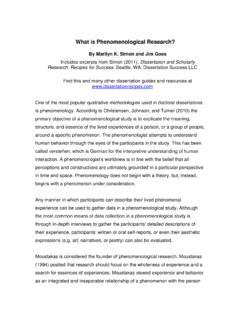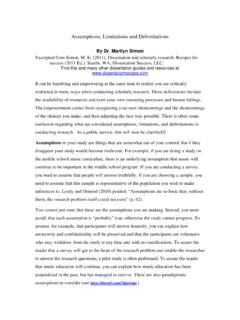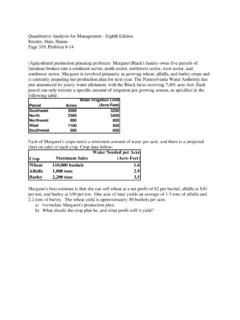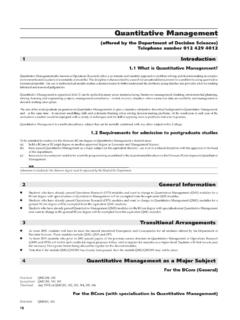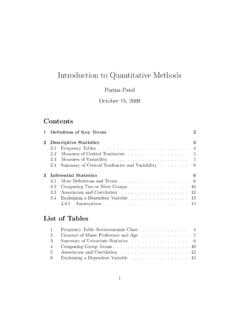Transcription of A Quantitative Study of Leadership and Conflict Management ...
1 A Quantitative Study of Leadership and Conflict Management Techniques used by Human Resource EmployeesProblem StatementnWorkplace violence is a critical issue facing leaders today and costs organizations in the United States an estimated $4 billion every year (Deborah, 2002)nThe problem the Study addressed was the need to understand the relationship between Leadership style and Conflict Management techniques human resource employees use in response to workplace violencenLimited attention and published research exist in the area of workplace violence in relation to Conflict Management (Porteous, 2002; Vega & Comer, 2005) nLeadership development in human resources has been identified as one of the most important issues in the field (Hernez-Broome & Hughes, 2004)2 Support for Problem StatementIncidents ofWorkplaceViolenceLeadershipBehaviorCon flictManagementOrganizationalCultureSoci al Psychology FrameworkBurke, 2006; Bordens& Horowitz, 2002; Deutsch, 1973; Schafer, 1968; Mendelsohn, 1956; Lewin,1936; Fiske& Taylor, 1991; Flavell& Miller, 1998; Augostinos& Walker, 1995; Laursenand Collins, 1994; Brown & Gibbons, 2005 ResolutionWithdrawal/AvoidanceMediation/ NegotiationProposedNew Research Exploring PossibleLinkage andRelationshipsLeadership Theory FrameworkBass & Aviolo, 2003; Bass et al.
2 , 1990; Yukl, 1989b; Bies& Tripp, 1996; Bennet, 1995 TransactionalLaissez-FaireTransformation alIndividual ReactiveBehaviorIndividual ReactiveBehavior3 Support for Problem StatementnRingstad (2005) first used the Revised Conflict Tactics Scale 2 (Straus et al., 1996) to gather data from social workers about workplace violence and Conflict Management techniquesnCTS2 developed to use with other instruments and (n=880) of sample experienced workplace violence in the last 12 monthsnData regarding the Leadership behavior and Conflict Management techniques of human resource employees have not been publishednSocial psychology provides the basis for the research Study and includes the perceptions and behavior of human resource employees in relation to violence, aggression, and Conflict managementcontinued4 Definition of Terms nConflict ManagementnKemp and Fry (2004) defined as using values to promote nonviolent behavior; avoidance of violence; promoting self-restraint and self-control.
3 Using processes for reaching consensus and minimizing hard feelingsnLeadershipnThe exercise of non-coercive influence, such as interpersonal influence and collective effort, to coordinate the members of an organized group to accomplishing the group s objectives (Barrow, 1977; Jago, 1982)5 Definition of Terms nWorkplace ViolencenThe attempted, threatened, or actual conduct of a person who endangers or is likely to endanger the health and safety of a worker, including any threatening statement, harassment, or behavior that gives a worker reasonable cause to believe the worker s health and safety is at risk (Nova Scotia Occupational Health & Safety Advisory Council, 1995)continued6 Significance of StudynInternal incidents of workplace violence in an organization are sometimes predictable and preventable (Bergin & Westwood, 2003.)
4 Mayhew, 2000)nBachman (1994) interpreted annual data from the National Crime Victimization Study in the United States and discovered, approximately half a million workers lost million days of work annually and victims lost more than $55 million in wages ( )7 Significance of StudynThe Study is significant at the organizational and academic levelsnAt the organizational level, the data provides human resource employees with information to implement training programs to increase safety in the workplacenVerbal assault ratesnRate of victimizationnAt an academic level, the data adds to the body of knowledge and creates new opportunitiesnTheory developmentnFocused future researchcontinued8 Research QuestionnWhat is the degree, if any, whereby Leadership style relates to Conflict Management used by human resource employees in response to incidents of abusive behavior (psychological aggression and physical assault) and physical forms of abuse (injury)?
5 9 HypothesesnNull hypothesis H1O- Leadership style, as reported by human resource employees, is not related to a type of workplace violence experienced. nAlternative hypothesis H1A- Leadership style, as reported by human resource employees, is related to a type of workplace violence hypothesis H2O- Leadership style, as reported by human resource employees, is not related to a Conflict Management strategy used in response to incidents of workplace violence. nAlternative hypothesis H2A- Leadership style, as reported by human resource employees, is related to a Conflict Management strategy used in response to incidents of workplace hypothesis H3O-the Conflict Management strategy used, as reported by human resource employees, is not related to a type of workplace violence experienced.
6 NAlternative hypothesis H3A-the Conflict Management strategy used, as reported by human resource employees, is related to a type of workplace violence Theories12 Perception of JusticeStatusInfluenceGroupBehaviorVicti mizationIndividualSchemaLeadershipConfli ctPowerSocializationSocial PsychologyMethodology nQuantitative, predictive, correlational Study measured the potential relationships between Leadership style and Conflict Management techniques of human resource employees in response to incidents of workplace violencenCombined Survey Tools Used for QuestionnairenRevised Conflict Tactics Resolution Scales 2 (CTS2) (Straus et al., 1996)nMeasures workplace violence and Conflict Management such as negotiation, accommodating, collaborating, compromisingnMultifactor Leadership Questionnaire (MLQ), Second Edition, Form 5x-Short (Avolio & Bass, 2002)13 LimitationsnThe Study used random sampling increasing the ability to generalize the findings (Creswell, 2005) and the Study was limited to the level of honesty from respondentsnValidity of the Study was also limited to the reliability of the instruments usednThe use of human resource employees may limit the ability to generalize the findingsnUnder-reporting of violent events may occur (Erickson & Williams-Evans, 2000)
7 14 DelimitationsnResearch focused on workplace violence, Conflict Management , and Leadership variables onlynSurvey tools widely tested; valid and reliablenSample frame representative of wide range of human resource employeesnSample frame had reliable and accessible contact information for members15 Population Under InvestigationnThe Bureau of Labor Statistics (2006) reported 880,000 employees in the field of human resources in 2004nThe sample frame of 204 people for the Study was obtained from the total population of 1,431 members of the Professionals in Human Resources Association (PIHRA)nPIHRA is the largest California chapter of the Society of Human Resource Managers Southern California geographic location only Reliable membership database renewed annually16 Samplen79 valid surveys were returned for analysis in the sample, a rate of Human ResourceEmployees 880,000 PIHRA Population1,431204 Person Sample Frame79 Person Sample17 Demographic FindingsnDemographic characteristics indicate the sample was predominantly female ( , n=61) between the ages of 31-40 ( , n=31) with most being highly educated and having a 4-Year College Degree or higher ( , n=62) 18 Demographic FindingsnA majority of respondents had A supervisory role ( , n=59) More than 26 years of work experience ( , n=26)
8 11-15 years of human resources experience ( , n=24)nA majority of respondents worked in an organization with more than 1000 employees ( , n=28)19051015202530< 5051-100101-250251-500501-1000> s Alpha for the combined surveys were .85 and reflected an acceptable level of internal consistencynNearly 1 in 2, or 43% (n=34) of respondents were victims of workplace violence during the last 12 months experiencing psychological assault, psychological aggression, or physical assaultnNo major injuries were sustained by respondents. When a minor injury occurred, the respondent rarely needed to seek the medical attention of a doctor (M= .13, or much less than once in the last 12 months)nThe most common form of physical assault was being grabbed (M=.)
9 34, or less than once in the last 12 months) followed having something thrown at them (M= .18, or less than once in the last 12 months)20 ResultsnThe most commonly reported acts of psychological aggression were products of verbal assaults such as being swore at (M= , or nearly twice in the last 12 months) or yelled at (M= , or nearly twice in the last 12 months)nMost of the incidents derived from Conflict resulted in the employee (M= , or more than once in the last 12 months) and not the respondent (M= , or less than once in the last 12 months) stomping out of the roomnRespondents scored in the mid-range for showing a coworker they cared (M= , or 3 to 5 times in the last 12 months) nShowing respect for a coworker during a disagreement scored the highest (M= , or 6 to 10 times in the last 12 months)
10 21continuedResultsnAgreeing to try a solution to a problem averaged more than twice in the last year (M= ) whereas suggesting a compromise to a disagreement occurred three to five times in the last 12 months (M= )nA Conflict may have persisted once identified which was indicated by a low frequency of respondents who were sure a problem could be worked out (M= , or more than once in the last 12 months)nMost respondents were scored as having a predominantly transformational Leadership style (M= ) followed by transactional (M= ) and laissez-fare (M= )22continuedResultsnCorrelation analysis completed on variablesnA slight positive correlation was found between: Negotiationand Transactional Leadership Style(r = .11, p = .00) Negotiationand Physical Assault-Major(r =.)




